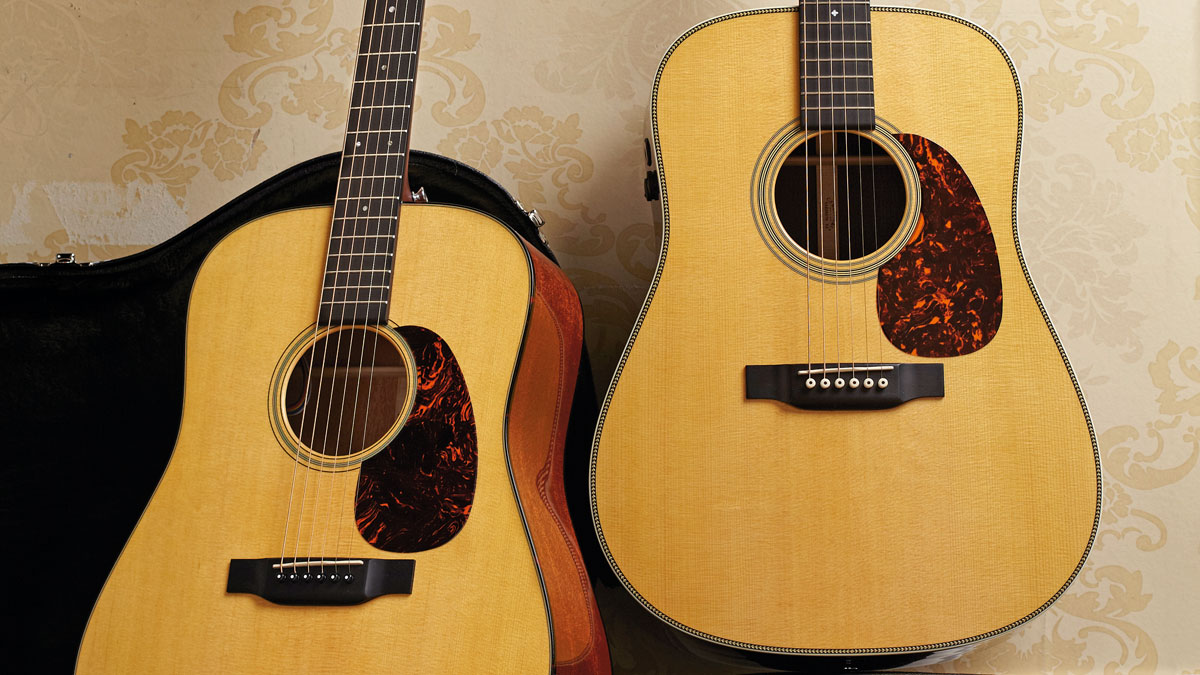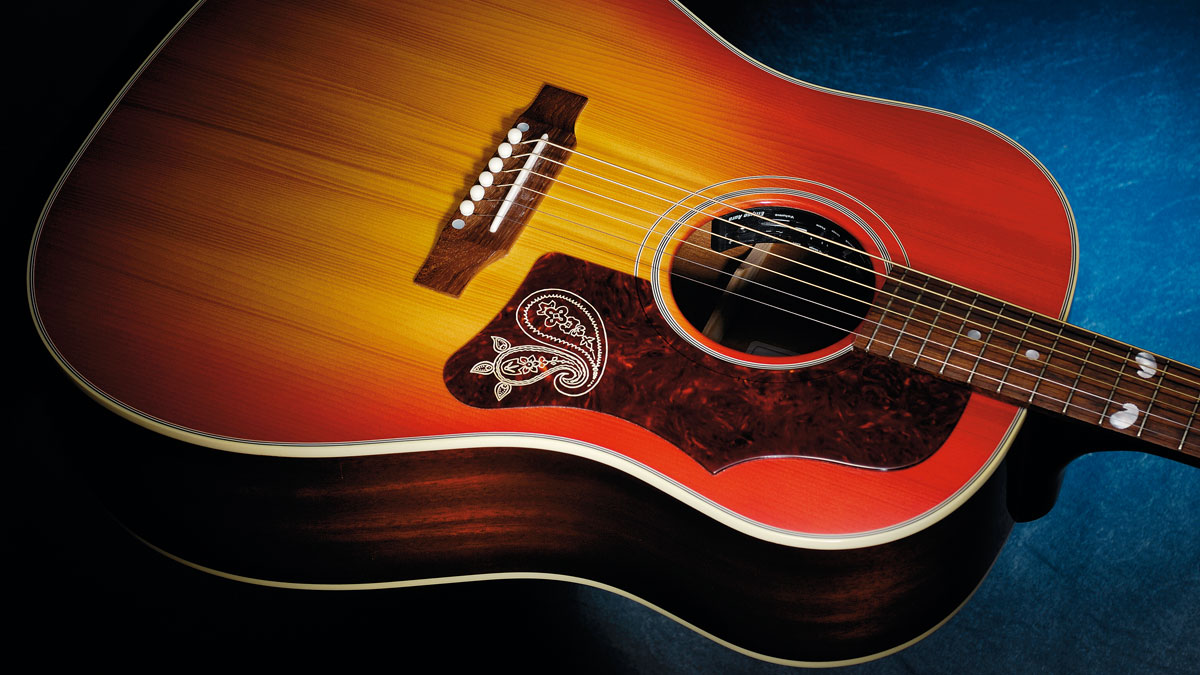
Introduction
These days, dreadnought acoustic guitars are commonplace in virtually every style of music you can name. Here’s how they rose to power…
History reveals that it was the CF Martin Company that first coined the name ‘Dreadnought’ for an acoustic body size.
The dreadnought was born, its powerful voice and lower-mid-rich tones finding favour with country artists
Named after a British battleship launched in 1906, the original craft was a turning point in naval history, bettering its rivals in terms of armament, speed, size and firepower. A few of those attributes could apply to the big-bodied beast of the unplugged world, too.
Strangely, the first dreadnought acoustics didn’t bear the Martin logo, but were made for the Oliver Ditson Company with production beginning in 1916, marketing being centred upon New York and Boston.
These models had 12-fret-to-the-body necks, slotted pegheads, no pickguards and with unique inlays and soundhole rosettes. However, in terms of construction, they featured mahogany backs and sides and spruce tops; since becoming pretty much standard with makers of dreadnought-style guitars worldwide.
Alas, the Martin-made Ditsons only lasted four years, as the Ditson company stopped trading in 1920. But in 1931 CF Martin added the D-1 and D-2 models to the range, the D-1 featuring mahogany backs and sides, the D-2, rosewood. Thus the dreadnought was born, its powerful voice and lower-mid-rich tones finding favour with country artists who at last had an instrument that would sit well with fiddles and banjos as an accompaniment to vocals.

Big G enters the picture
Around 1934, Gibson began making its own larger-body acoustics with the Jumbo flat tops including the J-35, so-called because of its $35 asking price. But it would be another 11 years before they brought out the model that would seriously challenge the might of Martin - the Gibson J-45.
Gibson’s J-45 first saw the light of day in 1942, right at the beginning of the USA’s involvement in World War II. You might think that this would have been a difficult time to launch a new model to the range, what with restrictions put in place on the use of resources like timber, metal and, more importantly, manpower.
It wasn’t long before Gibson’s ‘no frills’ dreadnought found its way into players’ hearts and it soon became known as ‘The Workhorse’
In fact, much of the company’s staff was involved in war-related projects and reserving spruce for guitar tops was considered secondary to its use in aircraft manufacture. This resulted in the first J-45s having multi-piece tops, with Sunburst the only finish initially available - a great way of disguising the joins in the timber.
Another effect that the war had upon manufacture resulted in a few models in 1943 having maple necks, as opposed to mahogany, and no truss rod, as metal was a precious commodity, most of it being diverted away from domestic use and into the war effort. Wartime J-45s have become sought-after among the collectorati mainly for the variations in build.
It wasn’t long before Gibson’s ‘no frills’ dreadnought found its way into players’ hearts and it soon became known as ‘The Workhorse’ because of its ability to suit virtually any style of music. It found particular favour with the blues players of the 40s and 50s, including Gary Davis, Skip James and Mississippi John Hurt.
Coming more up to date, players who have been seen with a J-45 in their hands include John Lennon, who reputedly learned his singular fingerpicking style from Donovan on one while attending The Beatles’ famous Indian retreat in Rishikesh in 1968.
Before then, both Buddy Holly and Bob Dylan made good use of the J-45, its distinctive tone in evidence on much of Dylan’s early work. Even today’s players are not immune to the J-45’s charms, as songsmith James Blunt is often seen wielding his treasured 1966 model.

And Your Bird Can Sing…
The Gibson Hummingbird started its life back at the beginning of the 1960s as the company’s answer to the more elaborate dreadnoughts that had started appearing in the Martin catalogue.
By this time, the dreadnought body shape had been accepted by players of all styles of music and was starting to become a favourite among the burgeoning array of folk singersongwriters appearing on the scene.
In terms of popularity, the Hummingbird was no doubt given a leg up by its appearance in the hands of The Byrds’ Gram Parsons
As far as the Gibson catalogue of the time was concerned, it was the second most ornate acoustic in its stable, playing second fiddle only to the J-200. But that status didn’t last for long, because the early 60s saw the introduction of the Dove, which sat in the price list between the Hummingbird and J-200.
Like its brother in arms, the J-45, the Hummingbird went through several variations with models such as the Custom, Koa Montana Special and Century appearing on the market in recent years. In terms of actual changes in spec, there have been many over time - some advantageous, some not.
An example of the latter category would include a screw-down scratchplate, whose short life on the production line was limited only to 1968 before everyone involved acknowledged that it was a very bad idea, and the infamous adjustable string saddle, which found no favour with players at all because of its apparent handicap to tone, but nonetheless managing to survive in place until 1970.
In terms of popularity, the Hummingbird was no doubt given a leg up by its appearance in the hands of The Byrds’ Gram Parsons, but several additional levels of cool were added when Led Zeppelin’s Jimmy Page appeared on TV in the UK in 1970 playing one on The Julie Felix Show. That particular event is possible to check out still in a video of exceedingly questionable quality on YouTube, if you care to click over and take a look.
The Hummingbird’s charms didn’t escape the notice of the early 1970s fusion players, either. Check out John McLaughlin playing with Tony Williams’ Lifetime in 1971 - all he needed to do was add a pickup, the rest was down to some phenomenal musicianship and the ’bird’s exceptional sonic capabilities.
Guitarist is the longest established UK guitar magazine, offering gear reviews, artist interviews, techniques lessons and loads more, in print, on tablet and on smartphones
Digital: http://bit.ly/GuitaristiOS
If you love guitars, you'll love Guitarist. Find us in print, on Newsstand for iPad, iPhone and other digital readers


